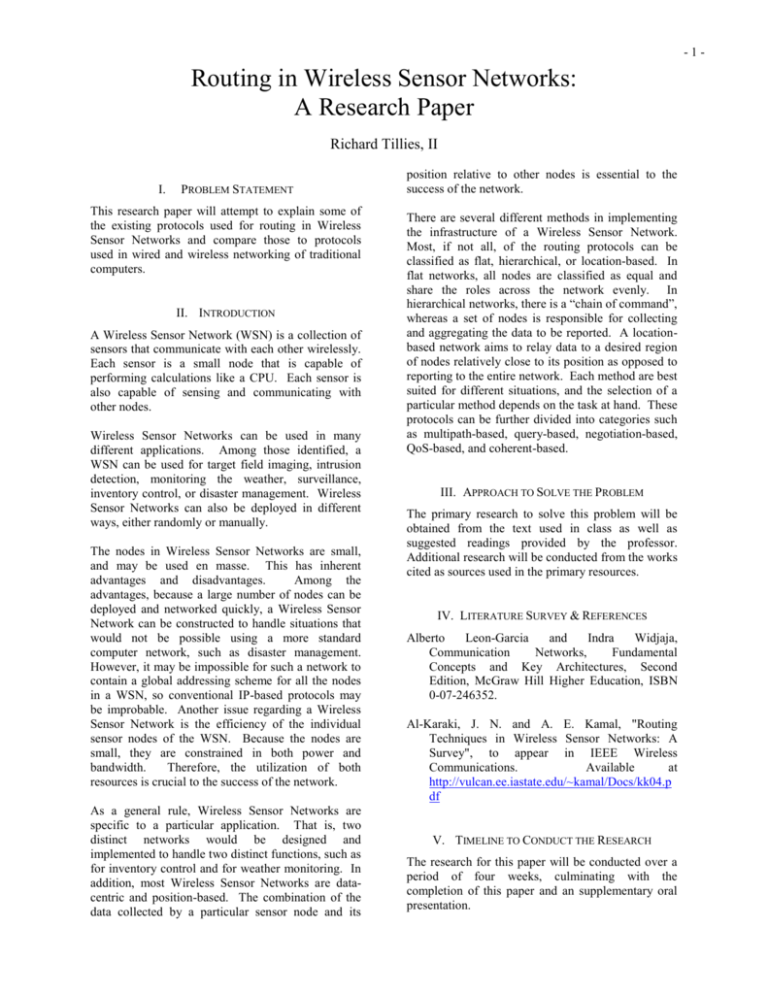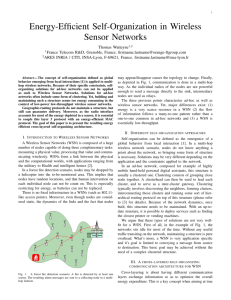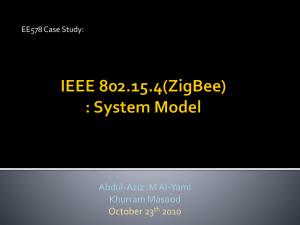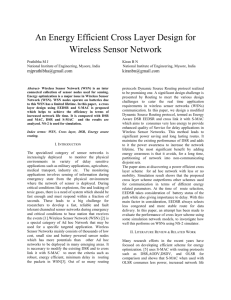Routing in Wireless Sensor Networks
advertisement

-1- Routing in Wireless Sensor Networks: A Research Paper Richard Tillies, II I. PROBLEM STATEMENT This research paper will attempt to explain some of the existing protocols used for routing in Wireless Sensor Networks and compare those to protocols used in wired and wireless networking of traditional computers. II. INTRODUCTION A Wireless Sensor Network (WSN) is a collection of sensors that communicate with each other wirelessly. Each sensor is a small node that is capable of performing calculations like a CPU. Each sensor is also capable of sensing and communicating with other nodes. Wireless Sensor Networks can be used in many different applications. Among those identified, a WSN can be used for target field imaging, intrusion detection, monitoring the weather, surveillance, inventory control, or disaster management. Wireless Sensor Networks can also be deployed in different ways, either randomly or manually. The nodes in Wireless Sensor Networks are small, and may be used en masse. This has inherent advantages and disadvantages. Among the advantages, because a large number of nodes can be deployed and networked quickly, a Wireless Sensor Network can be constructed to handle situations that would not be possible using a more standard computer network, such as disaster management. However, it may be impossible for such a network to contain a global addressing scheme for all the nodes in a WSN, so conventional IP-based protocols may be improbable. Another issue regarding a Wireless Sensor Network is the efficiency of the individual sensor nodes of the WSN. Because the nodes are small, they are constrained in both power and bandwidth. Therefore, the utilization of both resources is crucial to the success of the network. As a general rule, Wireless Sensor Networks are specific to a particular application. That is, two distinct networks would be designed and implemented to handle two distinct functions, such as for inventory control and for weather monitoring. In addition, most Wireless Sensor Networks are datacentric and position-based. The combination of the data collected by a particular sensor node and its position relative to other nodes is essential to the success of the network. There are several different methods in implementing the infrastructure of a Wireless Sensor Network. Most, if not all, of the routing protocols can be classified as flat, hierarchical, or location-based. In flat networks, all nodes are classified as equal and share the roles across the network evenly. In hierarchical networks, there is a “chain of command”, whereas a set of nodes is responsible for collecting and aggregating the data to be reported. A locationbased network aims to relay data to a desired region of nodes relatively close to its position as opposed to reporting to the entire network. Each method are best suited for different situations, and the selection of a particular method depends on the task at hand. These protocols can be further divided into categories such as multipath-based, query-based, negotiation-based, QoS-based, and coherent-based. III. APPROACH TO SOLVE THE PROBLEM The primary research to solve this problem will be obtained from the text used in class as well as suggested readings provided by the professor. Additional research will be conducted from the works cited as sources used in the primary resources. IV. LITERATURE SURVEY & REFERENCES Alberto Leon-Garcia and Indra Widjaja, Communication Networks, Fundamental Concepts and Key Architectures, Second Edition, McGraw Hill Higher Education, ISBN 0-07-246352. Al-Karaki, J. N. and A. E. Kamal, "Routing Techniques in Wireless Sensor Networks: A Survey", to appear in IEEE Wireless Communications. Available at http://vulcan.ee.iastate.edu/~kamal/Docs/kk04.p df V. TIMELINE TO CONDUCT THE RESEARCH The research for this paper will be conducted over a period of four weeks, culminating with the completion of this paper and an supplementary oral presentation.











